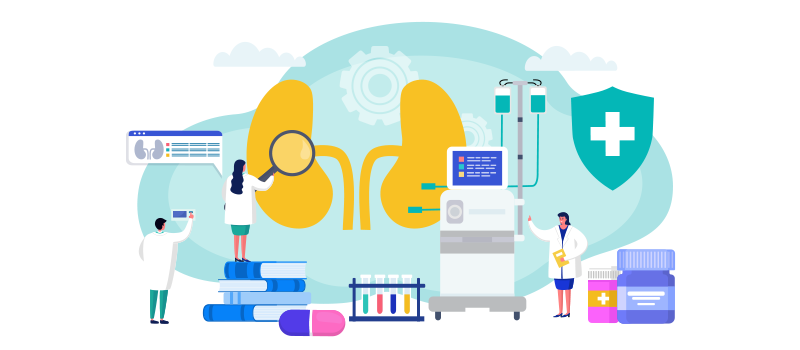Hemodialysis vs Peritoneal Dialysis: What’s the Difference?

The kidneys are responsible for removing wastes, excess fluids, and salt from the body. In people with kidney failure, for example, due to chronic kidney disease, the kidneys stop working properly and cannot perform this vital function. In such situations, healthcare providers may recommend a treatment called dialysis to filter blood. For example, you may need to undergo dialysis while you wait for a kidney transplant.
There are two types of dialysis - hemodialysis and peritoneal dialysis. The choice between them often comes down to the severity of your kidney disease and personal preference. Please continue reading to find out the differences between peritoneal and hemodialysis.
What is hemodialysis?
Hemodialysis is a method in which blood is pumped out of your body through tubes into an artificial kidney machine (dialysis machine) called a dialyzer. This artificial kidney filters waste, extra fluid, and salt and returns clean blood to your body. Most patients with kidney failure need hemodialysis three times a week. Each session lasts around 4 hours and is done in a dialysis center. Home hemodialysis may be possible in some cases.
What is peritoneal dialysis?
Peritoneal dialysis treatment involves using the peritoneum (inner lining of your abdomen or belly) as a natural filter to remove waste products, excess fluid, and salt. A sterile cleansing fluid called dialysate is introduced through an access point into the peritoneal cavity of your abdomen through a catheter and washed out after a set “dwell time.” The returned dialysis solution containing the filtered waste is thrown away.
There are three types of treatment options for peritoneal dialysis:
Continuous cycling peritoneal dialysis (CCPD)
This is a type of automated peritoneal dialysis that is done using a machine at home. It can be done while you’re sleeping.
Intermittent peritoneal dialysis (IPD)
This method of automated peritoneal dialysis uses the same equipment as CCPD but takes longer to complete and is typically done in a healthcare setting such as a hospital.
Continuous ambulatory peritoneal dialysis (CAPD)
This filtering process does not use a machine. Gravity moves the dialysis fluid from the sterile bag into the abdomen, and the dialysate flows out into a bag and is discarded. The fluid exchanges called passes are done 3-5 times a day while awake. Each pass takes 30-40 minutes to complete. You can perform continuous ambulatory peritoneal dialysis (CAPD) while you go about your normal activities.
What are the key differences between peritoneal dialysis and hemodialysis?
Hemodialysis is performed in a healthcare setting and requires adherence to a strict treatment schedule. Each hemodialysis session lasts around 4 hours. Peritoneal dialysis gives you more freedom with fewer restrictions on your daily life activities and travel. You can let peritoneal dialysis work as you go about your entire day.
Hemodialysis requires making changes to your diet and taking certain prescription medications. Peritoneal dialysis provides continuous cleansing of your blood. As a result, there is less buildup of waste products, sodium, potassium, and fluid in your body. Therefore, you can eat a more flexible diet on peritoneal dialysis than on hemodialysis.
If you have some residual kidney function, peritoneal dialysis is more likely to preserve it compared to hemodialysis.
Which is better: hemodialysis or peritoneal dialysis?
Both types of dialysis - hemodialysis and peritoneal dialysis - are effective. The choice between these dialysis options depends on several factors, including your kidney function, overall health status, lifestyle and home situation, ability to perform the treatments at home, and personal preferences. Your health care team will help you choose between hemodialysis vs peritoneal dialysis.
Peritoneal dialysis
Generally speaking, peritoneal dialysis is recommended for people who want less disruption of their daily life. It is a good choice for individuals with some residual kidney function and those with side effects from hemodialysis, such as muscle cramps or low blood pressure.
However, peritoneal dialysis may not be a good option for everyone. For example, it may not work in patients who have a medical condition such as abdominal scarring from previous surgeries, inflammatory bowel disease, hernia, and obesity. It also may not be an option in people who are unable to receive training and care for themselves.
Hemodialysis
Some patients prefer a hemodialysis procedure because they want healthcare professionals to handle their dialysis treatments rather than learning to do dialysis at home. It is the preferred method of dialysis in patients with more severe kidney disease and less kidney function.
However, receiving hemodialysis requires needlesticks each time. It also requires following a strict treatment schedule, making changes to your diet, and taking prescribed medications.
Additionally, there are certain side effects associated with hemodialysis, including muscle cramps, low blood pressure after treatments, high blood pressure in case of excess fluid or salt intake, fluid overload, anemia (low red blood cells), itching, and sleep difficulties. Complications of hemodialysis include pericarditis (inflammation around the heart), high or low potassium levels, infection or ballooning of the blood vessels (aneurysm) at the point of access, amyloidosis, and depression.
Why is peritoneal dialysis not popular?
Peritoneal dialysis may not be popular with some patients for the following reasons:
Firstly, this type of dialysis requires you to receive training and perform the treatment at home. Not following proper hygiene measures can increase your risk of infection. In contrast, hemodialysis is performed by healthcare professionals in a dialysis center and carries a lower risk of infections.
In addition, peritonitis (inflammation of the peritoneum) is a common complication of peritoneal dialysis treatments. Keeping the access point clean is important for preventing infections.
Another reason why some people do not prefer peritoneal dialysis is that the dialysis solution (dialysate cleansing fluid) contains a sugar called dextrose. This can be absorbed by the body, and the extra calories can lead to weight gain or cause or worsen diabetes (high blood sugar).
An additional risk is that the dialysis fluid in the abdomen can put pressure on the abdominal wall and cause a hernia in patients receiving peritoneal dialysis.
Lastly, peritoneal dialysis can become less effective over time, and many patients need to switch to hemodialysis.
Do you live longer with hemodialysis or peritoneal dialysis?
Studies have shown that peritoneal dialysis is associated with a higher survival rate, especially in the first two years of dialysis treatment. However, it is worth noting that peritoneal dialysis patients tend to be younger, have fewer comorbid health conditions, and are more likely to receive a kidney transplant compared to hemodialysis patients.
References:












SOCIAL